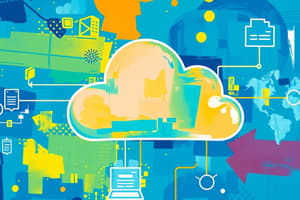Podcast
Questions and Answers
What is cloud computing?
What is cloud computing?
- The installation of data analytics software on client devices
- The purchase and maintenance of physical data centers and servers
- The creation of virtual representations of servers and networks
- The delivery of hosted computing services and IT resources over the internet (correct)
How do users access computing resources in cloud computing?
How do users access computing resources in cloud computing?
- By purchasing and operating servers on-premises
- By renting resources from a cloud provider over the internet (correct)
- Through physical data centers they own
- By installing virtual software on their devices
What is the role of virtualization in cloud computing?
What is the role of virtualization in cloud computing?
- It ensures secure storage of data on client devices
- It creates virtual representations of physical hardware (correct)
- It helps businesses invest in physical hardware
- It optimizes the management of cloud applications
Who owns and operates the remote data centers in cloud computing?
Who owns and operates the remote data centers in cloud computing?
Why do businesses use virtualization in cloud computing?
Why do businesses use virtualization in cloud computing?
What is the primary benefit of cloud computing for organizations?
What is the primary benefit of cloud computing for organizations?
What is the main concept of service-oriented architecture (SOA)?
What is the main concept of service-oriented architecture (SOA)?
How do services in a service-oriented architecture (SOA) communicate with each other?
How do services in a service-oriented architecture (SOA) communicate with each other?
What is the primary goal of grid computing?
What is the primary goal of grid computing?
In utility computing, how are charges for computing resources determined?
In utility computing, how are charges for computing resources determined?
What distinguishes utility computing from other models of service provisioning?
What distinguishes utility computing from other models of service provisioning?
Flashcards are hidden until you start studying




